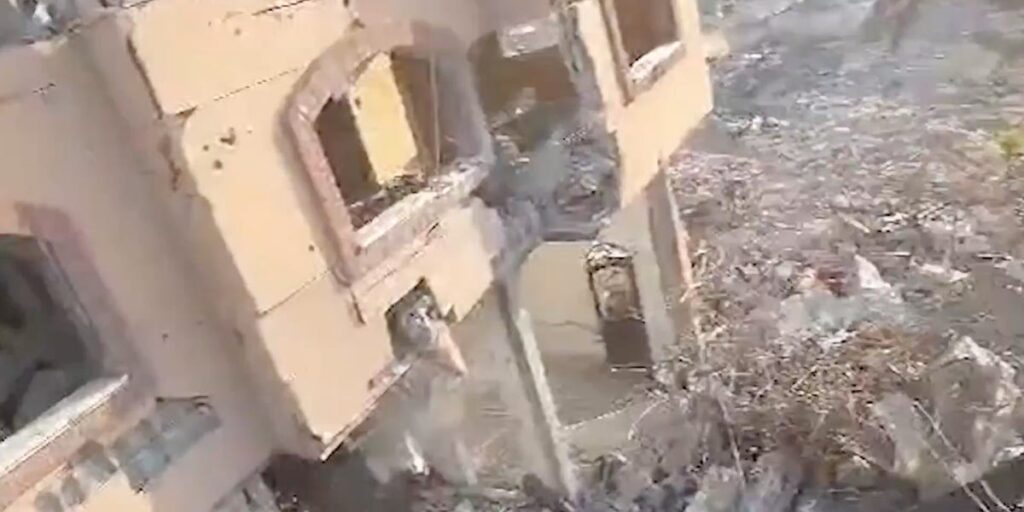- Israel released a video on Thursday of what it said were Yahya Sinwar’s final moments.
- The clip shows a drone hovering close to a dirt-covered figure as they throw a stick at the camera.
- It’s yet another display of how drones have radically changed wartime surveillance.
The video is chilling. A camera glides through the open window of a ruined building scattered with wrecked furniture, and hovers close to a lone figure in an armchair.
A person caked in dust, their face obscured by a headscarf, turns to face the drone, their right forearm clearly missing as though blown off by an explosive. The figure tosses a plank toward the drone.
These, Israeli officials say, were the last moments of Hamas leader Yahya Sinwar.
Sinwar had hid from Israeli forces for more than a year after the Oct. 7, 2023 rampage he orchestrated, but the net was closing in. The eerie video of his alleged final moments is a product of this wide surveillance net and one that can capture images in areas too dangerous for troops with an almost cinematic quality.
Though Sinwar was believed for months to be closely protected by bodyguards or possibly shielded by hostages, the 61-year-old Hamas leader was caught with only a small guard detail above ground, Israeli officials said.
Only 13 years ago, the world learned of what were Muammar Gaddafi’s last few moments through shaky video filmed on cellphones.
Bloodied and exhausted after being dragged out of a drainage pipe, the deposed Libyan dictator can be heard asking for mercy.
Cellphones were becoming ubiquitous even across impoverished areas back then. But a little over a decade later, the ability of armed groups to watch their adversaries has sped far past clips caught on phones, and is spilling into public view.
Drones have now flooded battlefields around the world.
Standards for remote surveillance, once limited to still photos and grainy video from miles up in the sky, now revolve around cameras that can literally float a few feet away from a target like Sinwar, feeding live images back. This makes it possible to espy most enemy movements and potentially strike them.
The need for accurate surveillance stems from the development of long-range precision warfare over the last 50 to 70 years, said Mauro Gilli, a researcher in military technology and international security at Swiss university ETH Zurich.
It’s now possible to strike targets “way beyond visual range,” he said.
Being able to accurately identify what you’re about to strike becomes crucial — whether that’s with daylight drone cameras, thermal imaging, radar, or electronic signals, he said.
In the context of the killing of Sinwar, the drone’s position allowed combatants “to approach a potentially threatening area without risk for the troops,” Gilli said.
A dizzying proliferation
It’s become apparent that a human presence is no longer essential to tell us what’s happening on the battlefield, spreading capabilities that had once been the sole preserve of top militaries like the US.
That’s already a key feature of the war in Ukraine.
Ukrainian and Russian troops alike post dozens of drone videos a week to online forums and social media, showing clip after clip of ambushes, clashes, airstrikes, and artillery assaults.
These are more than just propaganda to try to rally the war’s backers. Think tanks, war experts, journalists, and governments alike now rely on drone footage as an everyday source of information — that still can be misleading.
And the drone game is just getting started.
Militaries around the world are investing billions into their own arsenals of uncrewed aerial systems, spurred on by the rapid emergence of the technology.
“We see it in the stock market, with all the high tech from semiconductors, microelectronics, you name it,” said Gilli. “All these technologies, they have become much more powerful.”
The hovering quality of the Sinwar video indicates it was likely filmed by a quadcopter. These drones, popular with photographers and racers, often cost hundreds of dollars and have advanced so rapidly that they have military uses. Unlike soaring fixed-wing drones, quadcopters can fly into bunkers and buildings in the hands of a skilled pilot.
The Pentagon plans to spend $1 billion in the next two years on low-cost drones, and earlier this year Ukraine said it was setting up what is likely the world’s first military branch devoted solely to drone warfare.
On Monday, Ukrainian President Volodymyr Zelenskyy said that Ukraine had procured and delivered one million drones to the battlefield, according to Ukrainian state media outlet United24.
Moscow, too, has pledged to produce millions of first-person drones annually.
Commentators have already begun asking if even that number will be enough.
Maria Berlinska, a drone operator and founder of volunteer drone training project Victory Drones, estimated that Ukraine would actually need four times that many, according to local outlet TCH.
The ‘transparent’ battlefield
The sheer volume of reconnaissance and exploding drones has profound implications that are far from clear.
The astounding wealth of drone-fed intelligence, surveillance and reconnaissance has made more of the battlefield visible than ever before.
Ukraine’s shock incursion into Kursk on August 6 has challenged those who argue the increasingly “transparent” battlefield makes surprise nearly impossible, according to one US Army assessment of the attack. Another example is that Israel’s military failed to recognize preparations for the Hamas attack despite its surveillance assets.
Nonetheless, technological advances mean that drones watching the battlefield will be a ubiquitous feature of future wars, a looming threat to ground troops and fleeing leaders.
Back in Israel, officials told local media that Israel intends to release even more drone footage of Sinwar, though it said these clips will be of the Hamas leader before the October 7 terror attacks last year.
The Times of Israel reported that the IDF said the footage would show Sinwar entering and exiting a tunnel, escorting family members, and moving supplies such as a plasma TV.
Read the full article here


